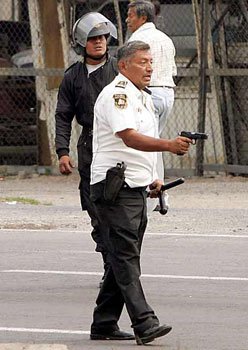


The “Dirty War” Returns to Mexico
San Salvador Atenco Attacks Follow Blueprint of Terror from the 70s and 80s
By John Ross
Blindman’s Buff
May 18, 2006
MEXICO CITY (May 20th): Between 1970 and 1982, three Mexican presidents waged a “dirty war” against dissidents from one end of the country to the next. Recently compiled documentation lists 15,000 illegal detentions during that terrible period, thousands of instances of torture, and the forced disappearance of more than 700 Mexican citizens (see “Disappearing the Disappeared” upcoming next week).
Nowhere was the dirty war more cruelly fought then along the Pacific coast of Guerrero state where farmers had risen in rebellion behind the rural school teacher-turned guerrillero Lucio Cabanas and his Party of the Poor. Carlos Montemayor, author of “War In Paradise,” perhaps the most vehement expose of that repression, is an assiduous scholar of how the dirty war in Guerrero was organized and carried out.
 Photos: Indymedia Mexico |
According to Montemayor’s description, first an overwhelming force is assembled with the primary mission of totally subjugating a recalcitrant population. Then informers are introduced into the village to identify and eliminate rebel community leaders and those associated with them. If the leaders evade capture, their families are held hostage. Young men are rounded up and selectively tortured to extract information and to turn them into “soplones” (informers.)
Meanwhile, shock troops terrorize the civilian population into submission. Indiscriminate beatings, home invasions, the theft of personal items of value, and the systematic destruction of property are encouraged by police commanders. Women are raped and sexually abused to underscore the occupation force’s total domination over the rebellious villagers.
Virtually all of these dirty war characteristics were on display in San Salvador Atenco May 4th when 3000 armed state police and elements of the Federal Preventative Police (PFP), a force largely extracted from the Mexican military, slammed into that dirt-poor town of 30,000 out on the dried lake beds east of the capital, killing one 14-year-old, leaving a 20-year-old student hovering between life and death, and arresting 209, all of whom required hospitalization from the beatings they received under security force batons – although only some prisoners actually received it (and they were chained to their hospital beds.) Of 47 women arrested, 23 reported that they had been raped or were otherwise sexually abused. One 53 year-old mother who had gone to a local store to buy a birthday present for her son was forced to perform oral sex on three police “officers” to avoid arrest.
 |
One object of such collective repression, noted Montemayor, is the identification and elimination of local leadership. In Atenco, the most identifiable voice of the farmers’ rebellion is Ignacio del Valle, a leader of the Popular Front for the Defense of the Land whose militants picked up their broad machetes three years ago and successively defended the town’s corn lands from expropriation by President Vicente Fox for a new, multi-billion dollar Mexico City International Airport, thereby incurring the undying scorn of the president and his cronies who stood to make a killing on the deal.
Nacho del Valle and his second-in-command Felipe Alvarez were captured on the first day of the fighting and immediately clapped into Mexico’s maximum lock-up at nearby La Palma on “kidnapping” charges that evolved from an acrimonious February meeting with Mexico state officials – the charges carry 30 to 50 year prison sentences. 26 other members of the Popular Front have since been incarcerated on the same charge.
As per Carlos Montemayor’s script, Del Valle’s immediate family was singled out for special repression. Their home was destroyed by invading police and one son was disappeared for several days until he turned up badly beaten in a Mexico state prison. Nacho’s daughter, América, increasingly the spokesperson for the Popular Front to Defend the Land, has been forced into hiding.
In classic dirty war mode, police brought in ski-masked informers who went from house to house pointing out Popular Front sympathizers. Police broke down doors and invaded private homes without warrants, firing weapons, beating the residents bloody, and smashing the furniture into kindling.
 |
Lorena, a diminutive 22 year-old “adherent” to the Other Campaign, tells of being beaten and manhandled by arresting officers and then thrown into a truckful of women prisoners who had been beaten so badly that their blood covered the floor of the vehicle. Ordered to lie face down on top of the injured women, one police “officer” ripped off her pants and upon discovering that she was menstruating, began beating her, screaming that he would make her “really bleed.” Later, he or one of his fellow “officers” tried to anally penetrate Lorena but was warned off because the truck was nearing the prison. In anger, the “officer” smashed Lorena’s head into the truck wall.
Women are considered “botines” (prizes) in the dirty war, Montemayor explains, and the violations of the women from Atenco were not so much sexual as they were an expression of male government domination – all part of the dirty war plan.
Four of the arrested and abused women were non-Mexicans and immigration authorities swooped in before they could reveal what had happened during the nightmare ride from Atenco May 4th. Despite ten years of residence in Mexico, Valentina Palma, a Chilean filmmaker who was shooting a documentary in Atenco, and her companion Mario Guerrero were summarily deported under Article 33 of the Mexican constitution which allows the president to kick out any foreigner deemed “inconvenient.”
Other deportees included Samantha Deitmar, a German documentarian, and two Catalanes Maria Sostres and Cristina Valls, all of whom were physically abused. The women pledge to take legal action against the Fox administration and appeal their summary deportations.
400 foreign human rights observers were deported from Chiapas by former president Ernesto Zedillo, most after the 1997 Acteal massacre of Zapatista supporters, to prevent dissemination of first hand accounts of abuses in that southernmost Mexican state. While Fox has been more selective in booting out “inconvenient” foreigners, in 2003 he ordered the deportation of 17 Evergreen University (Washington state) students and their professor for marching alongside the “Macheteros” of Atenco, then battling Fox’s airport, in the annual May 1st International Workers Day mobilization.
In the Montemayor model, collective assaults such as at Atenco are not improvised attacks by out-of-control security forces but meticulously plotted at the highest echelons of power. Such operations invariably involve more than one agency so a high degree of coordination is required. The chain of command often goes straight to the top. Overall responsibility for the assault on San Salvador Atenco fell to Fox’s Secretary of Public Security Eduardo Medina Mora, former chief of the CISEN, Mexico’s lead national security investigative police agency.
In charge on the ground was Mexico state public security director Wilfrido Robledo, the disgraced ex-head of the Federal Preventative Police under Zedillo and cousin of narco kingpin Mario Villanueva Madrid, former governor of Quintana Roo who is currently doing long time in the same maximum-security prison that now houses Nacho del Valle and the leadership of the Popular Front.
Five regional PFP commanders were brought in to coordinate logistics. As has been the modus operendi in other recent government assaults on farmers and workers groups in resistance, elite state police sharpshooters led the May 4th retaking of San Salvador Atenco backed up by baton-wielding federal robo-cops.
Carlos Montemayor’s blueprint for such dirty war thrusts includes the minimizing of press presence to limit the political outfall from such operations – either by silencing the press or “embedding” reporters in security force ranks. At Atenco, reporters were allowed through police lines on the first day of combat to film acts of vandalism by the infuriated farmers but the next day were grouped behind the invading police to record the re-taking of the town. Nonetheless, despite manipulation by both authorities and their own editors, television crews caught some of the most stomach-wrenching footage of police brutality ever shown on Mexican TV screens.
Finally, Carlos Montemayor points out that because such collective repression is bound to be politically damaging, the political class must sign off on acts of state violence either prior to the attack or once the repression has been accomplished. The assault on Atenco was no exception. Vicente Fox, his right wing PAN party, and its presidential candidate Felipe Calderon, along with once-ruling (71 years) Institutional Revolutionary Party (PRI) standard-bearer Roberto Madrazo all endorsed the “hard hand” (“mano dura”) shown at Atenco. The repression was also tacitly approved by left-center challenger Andres Manuel Lopez Obrador of the Party of the Democratic Revolution (PRD) who declined to condemn the police brutality. Another big booster: Mexico state governor Enrique Peña Nieto who a week after the bloody confrontation sent thousands of gallons of paint to San Salvador Atenco to white wash the damaged town.
In contrast to the candidates and their political parties, the Zapatistas’ Other Campaign, an anti-electoral crusade designed to weld together Mexico’s underclass in an anti-neo-liberal alliance, has raised the atrocities committed at Atenco as a flag of resistance. With the EZLN’s quixotic spokesperson Subcomandante Marcos leading marches and inspiring solidarity protests against the Fox government, demonstrations took place last week (May 10th-17th) in 17 countries and 34 cities in support of the farmers of Atenco.
One of those cities was Vienna, Austria where President Fox was greeted by demonstrators shouting their outrage at human rights abuses in Atenco as he arrived for a Latin America-European Union summit.
Ironically, the San Salvador Atenco atrocities took place the same week Mexico assumed a position on the newly revised United Nations Human Rights Commission in Geneva, alongside such formidable human rights abusers as China, Russia, Cuba, and Saudi Arabia. Mexico joins the commission “with its hands bloodied” by the repression in Atenco, bemoaned National Human Rights Commission ombudsman Jose Luis Soberanes, an outspoken critic of the Fox regime’s human rights record.
“We are again convoked by our pain” Subcomandante Marcos told thousands in a driving rainstorm a mile from the presidential palace on Friday, May 12th after a long week of solidarity actions. “Who can listen to the stories of the women of Atenco, to the men, to the old people who were beaten, and the youth, and remain indifferent? No, not us, not those who are part of the Other Campaign.” Marcos reaffirmed that the Other Campaign will remain in Mexico City indefinitely until all the farmers of Atenco are released from prison.
John Ross is in California, watching basketball. Making Another World Possible – Zapatista Chronicles 2000-2006 is in New York being inspected by editors. Ross will return to Mexico in early June to report on the final spasms of the presidential election race and the twitchings of the Other Campaign.
Click here for more Narco News coverage of Mexico
Lea Ud. el Artículo en Español
Legga questo articolo in italiano
- The Fund for Authentic Journalism
For more Narco News, click here.




